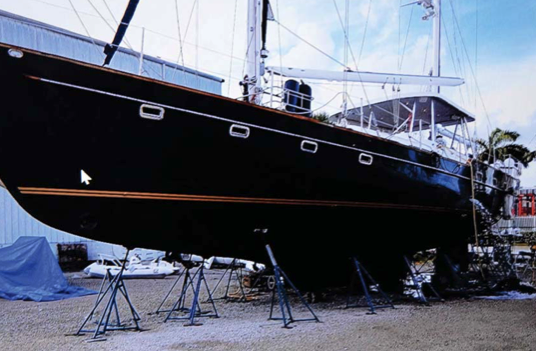James Shackleford paid $120,000 for a 65-foot sailboat in 2009, hoping to fix up the vessel and one day sail around the globe.
That voyage never happened. Instead, the yacht that Shackleford christened Sea the World was struck by lightning. Its hull was allegedly damaged when hauled out of the water for repairs, and then it was partially submerged when blown by a storm against a sea wall. Disputes stemming from damages to the boat trekked three times though federal district courts and twice reached the 11th Circuit Court of Appeals.
A decade after its purchase, Sea the World now sits atop stanchions in a boat yard near Palm Beach, barred from the sea until a $220,000 storage bill is paid. Litigation over that continues, but the latest suit is only the unfinished tail end of a very long voyage through the federal civil court system.
Navigation limits
The first dispute about damage to Sea the World ended with a settlement that brought Shackleford more than three times the amount he paid for the vessel. The second ended in a draw, of sorts. The third dispute was resolved by the 11th Circuit on Tuesday in a ruling that reversed the district court and found that damages to Sea the World were not covered by Shackleford’s insurance policy.
The appellate court said the terms of the policy issued by Geico Marine Insurance Co. quite clearly excluded coverage if Sea the World sailed anywhere south of Cape Hatteras, North Carolina during the June 1 to Nov. 1 Atlantic hurricane season.
“The vessel suffered damage while afloat during a storm in Florida in early June,” the appellate panel said in an opinion written by Judge William Pryor. “Because the vessel was outside of the covered navigational area when the loss occurred, the policy does not cover the loss.”
The circumstances by which Sea the World ended up outside its navigational limits in early June 2016 provides a cautionary tale about the importance of understanding the terms of an insurance policy. St. Petersburg, Fla. attorney Craig Berman, who represented Shackleford both at district court and appeal, said his client lives in Palmetto, Fla. and would not have bought the policy if he was aware of the navigational limit.
Berman said Shackleford told the agent who answered his call at U.S. Boatworks that he was moving the vessel from dry-dock storage in Bradenton, Fla. to Fort Lauderdale for extensive repairs. Instead of issuing a new policy, the agent amended an existing “port risk ashore” policy to add an endorsement that allowed navigation. The policy covered the vessel’s hull for up to $264,000. Berman said the agent didn’t mention the restriction against travel south of Cape Hatteras during hurricane season.
Shackleford sailed on May 27 and anchored in Fort Lauderdale’s Lake Sylvia. Berman said Shackleford might have made it to the repair facility had there not been an overhead power line that he feared might arc if his 95-foot mast passed too close. Shackleford weighed anchor. That anchor dragged across the bottom when wind from an incoming Atlantic thunderstorm pushed Sea the World into a sea wall.
Shackleford filed a claim claim with Geico, but the insurer denied it, citing the “navigational limit” in the policy.
U.S. Judge James D. Whittemore had ruled that the exclusion was ambiguous. The policy referred to “navigational area” on the policy’s declarations page, but the declarations page actually contained “cruising limits.” The “Navigation Area” in the endorsement section was left blank. The judge ruled that any ambiguity created by inconsistency between the endorsement section and the declarations page has to be construed in favor of the policyholder.
The 11th Circuit, however, said the policy was perfectly clear. “Nothing in this record supports the conclusion that Geico Marine voluntarily and intentionally relinquished its right to enforce the navigational limit,” the court’s opinion says. “The district court erred in ruling otherwise.”
Berman said the 11th Circuit essentially “retried the case” and he plans on asking for a rehearing en banc, meaning a ruling by all of the active judges on the appellate court instead of just the three-judge panel. He acknowledged that such requests are rarely granted. “They are infallible because they are final, they aren’t final because they are infallible,” he said of the appellate court.
Lightning Strike
Shackleford had better luck the first time he went to court over damages to Sea the World.
Berman said Shackleford spent $600,000 to $700,000 on repairs after buying the boat in 2009. But in 2011, the boat was struck by lightning while moored offshore in the Tampa Bay Area.
Shackleford had purchased insurance through U.S. Boatworks — the same agency that sold him the Geico policy years later — except the first time the underwriter was CNA’s Continental Insurance Co. He had the vessel towed to Sailor’s Wharf, a repair facility in St. Petersburg that was on U.S. Boatworks’ list of guaranteed repair facilities, Berman said.
Shackleford alleges that the hull of the vessel was warped while it was being hauled out of the water because Sailor’s Wharf did not use enough straps to hoist its 53 tons. Continental brought in an expert who deemed the yacht a “constructive total loss” and paid $512,811.39 to settle two separate claims; one for the lightning damage and the other for the hull damage.
While the boat’s stated value was only $295,000 according to his policy with Continental, Berman said he was able to collect on both claims because of the guarantee that came with the use of a U.S. Boatworks preferred repair facility. Continental also allowed him to keep the vessel instead of taking ownership and selling it for scrap value, which is the more usual practice. What’s more, Continental surrendered its subrogation rights in the settlement.
Shackleford filed a separate lawsuit against Sailor’s Wharf for breach of its repair contract — a dispute that indirectly brought Sea the World for a second trip to the 11th Circuit Court of Appeals.
Shackleford rejected an initial $35,000 settlement offer and fired the attorney who brought it to him. He hired Berman, but things didn’t go well. On the second day of trail, Shackleford accepted a $30,000 settlement. The first lawyer petitioned the court to be paid his agreed contingency fee. That dispute eventually went to the 11th Circuit, which affirmed a district court ruling that the first lawyer was owed $13,037.67 of the settlement amount, with the rest going to Shackleford’s first lawyer.
John D. Kallen, a North Miami Beach attorney who represented Sailor’s Wharf, said he doesn’t believe his client caused any actual damage to Shackleford’s boat. He said the litigation was “a total mess.” The expert who first testified that the boat was a total loss changed his testimony and said the boat could be salvaged, Kallen said. Shackleford took Sea the World to another storage facility without paying the final bill, Kallen said. Sailor’s Wharf had to call St. Petersburg police to get its money. During the course of the litigation, Shackleford said one time during interrogatories that his boat was worth only $50,000, but another time that it was worth $750,000, according to a district court summary of the case. Kallen said the case was a “nightmare” for his client.
“He wanted hundreds of thousands of dollars,” Kallen said. “For $30,000 to get rid of this guy, it was well worth it.”
Cancellation and Impound
But Sea the World’s journey through the courts wasn’t over.
Shackleford decided to give Sea the World a second chance — constructive total loss or not. During the litigation with Sailor’s Wharf, he had arranged for an expert witness from Taylor’s Boatworks in Bradenton to inspect his vehicle. The inspection showed that the warped hull had returned to a more normal shape, which persuaded Shackleford that Sea of the World could be repaired, according to court filings.
He moved his yacht to Fort Lauderdale, which led to the storm damage and the failed litigation against Geico. While the litigation was ongoing, Shackleford stored his boat at Cracker Boy Boat Works in Riviera Beach.
Berman said in August 2016, Geico cancelled Shackleford’s insurance policy for Sea the World “ab initio,” meaning as if it were never in place. Also that August, Cracker Boy told Shackleford that it would not allow him to move the vessel unless it was insured.
Shackleford filed suit. In a complaint filed in Palm Beach County court, Berman argues that Shackleford never executed a rental contract Cracker Boy because he never paid the rent that was due. The complaint states that Shackleford would have paid the rent had Cracker Boy not demanded that the craft be insured before leaving the boat yard. Nothing in Florida statutes requires facilities to require that vessels purchase insurance before launching, the suit says.
According to the suit, Cracker Boy scheduled an auction to sell the yacht in December 2017. Shackleford posted a $50,000 bond with the county to secure release of the vehicle which he says is now worth $345,000, but Cracker Boy still refused to let Shackleford have his boat back, according to the suit.
Berman said Cracker Boy is now demanding $220,000 in past-due rent. The lawsuit asks the court to reduce that amount. Geico is named as a co-defendant.
“This whole thing is a mess caused by Geico,” Berman said.
Photo of Sea the World courtesy of Craig Berman.
Was this article valuable?
Here are more articles you may enjoy.


 Report: Claims Handlers Embracing Technology
Report: Claims Handlers Embracing Technology  UnitedHealth Data Leak May Affect ‘Substantial’ Swath of U.S.
UnitedHealth Data Leak May Affect ‘Substantial’ Swath of U.S.  CoreLogic Report Probes Evolving Severe Convective Storm Risk Landscape
CoreLogic Report Probes Evolving Severe Convective Storm Risk Landscape  Florida’s Home Insurance Industry May Be Worse Than Anyone Realizes
Florida’s Home Insurance Industry May Be Worse Than Anyone Realizes 